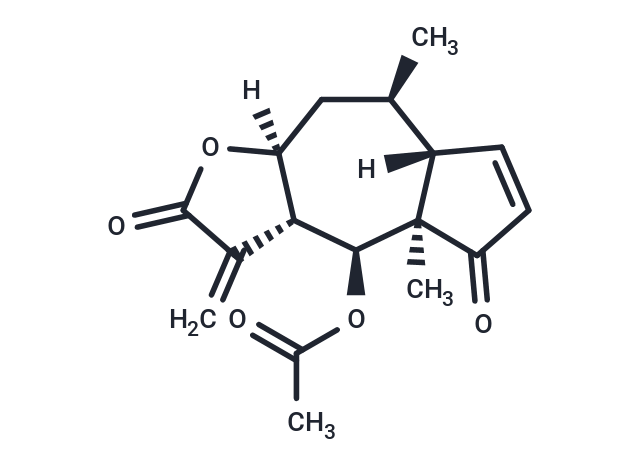Shopping Cart
- Remove All
 Your shopping cart is currently empty
Your shopping cart is currently empty

Bigelovin is a selective retinoid X receptor α agonist. Bigelovin suppresses tumor growth through inducing apoptosis and autophagy via the inhibition of mTOR pathway regulated by ROS generation.It is also known as a potent cytotoxic sesquiterpene lactone from Inula sp.

| Pack Size | Price | Availability | Quantity |
|---|---|---|---|
| 1 mg | $93 | In Stock | |
| 5 mg | $228 | In Stock | |
| 10 mg | $297 | In Stock | |
| 25 mg | $516 | In Stock | |
| 50 mg | $736 | In Stock | |
| 100 mg | $987 | In Stock | |
| 1 mL x 10 mM (in DMSO) | $226 | In Stock |
| Description | Bigelovin is a selective retinoid X receptor α agonist. Bigelovin suppresses tumor growth through inducing apoptosis and autophagy via the inhibition of mTOR pathway regulated by ROS generation.It is also known as a potent cytotoxic sesquiterpene lactone from Inula sp. |
| In vitro | BigV exhibited potential anti-tumor activities against human liver cancer in vitro and in vivo.?BigV reduced the cell proliferation and colony formation.?BigV induced apoptosis through improving the cleavage of Caspase-3 and poly (ADP-ribose) polymerase 1 (PARP-1).?The process was along with the activation of autophagy, as proved by the enhanced accumulation of autophagosomes, the microtubule-associated light chain 3B-II (LC3B-II) and Beclin-1, and p62 decrease.?Further, the autophagy blockage markedly sensitized BigV-induced cell death, indicating the cytoprotective function of autophagy in liver cancer cell lines.?In addition, BigV treatment inactivated the pathway of protein kinase B (AKT)/mammalian target of rapamycin (mTOR)/ribosomal protein S6 kinase (p70S6K).?Of note, BigV-induced cell death was abolished by over-expressing the phosphorylation of mTOR.?Intriguingly, the induction of apoptosis and autophagy were eliminated by the pretreatment of reactive oxygen species (ROS) scavenger N-acetyl-l-cysteine (NAC), suggesting that ROS played an important role in the regulation of BigV-induced cell death. |
| In vivo | In vivo studies demonstrated that BigV significantly suppressed the growth of HepG2 cancer xenograft tumors through the activation of apoptosis and autophagy in a dose-dependent manner with low systemic toxicity.?Revealed that BigV had significant antitumor effects against human liver cancer and it may potentially be used as a novel antitumor agent for the prevention of liver cancer. |
| Molecular Weight | 304.34 |
| Formula | C17H20O5 |
| Cas No. | 3668-14-2 |
| Smiles | [H][C@]12C[C@@H](C)[C@]3([H])C=CC(=O)[C@@]3(C)[C@@H](OC(C)=O)[C@@H]1C(=C)C(=O)O2 |
| Relative Density. | 1.22 g/cm3 (Predicted) |
| Storage | Powder: -20°C for 3 years | In solvent: -80°C for 1 year | Shipping with blue ice. | |||||||||||||||||||||||||||||||||||
| Solubility Information | DMSO: 60 mg/mL (197.15 mM), Sonication is recommended. | |||||||||||||||||||||||||||||||||||
Solution Preparation Table | ||||||||||||||||||||||||||||||||||||
DMSO
| ||||||||||||||||||||||||||||||||||||

Copyright © 2015-2025 TargetMol Chemicals Inc. All Rights Reserved.